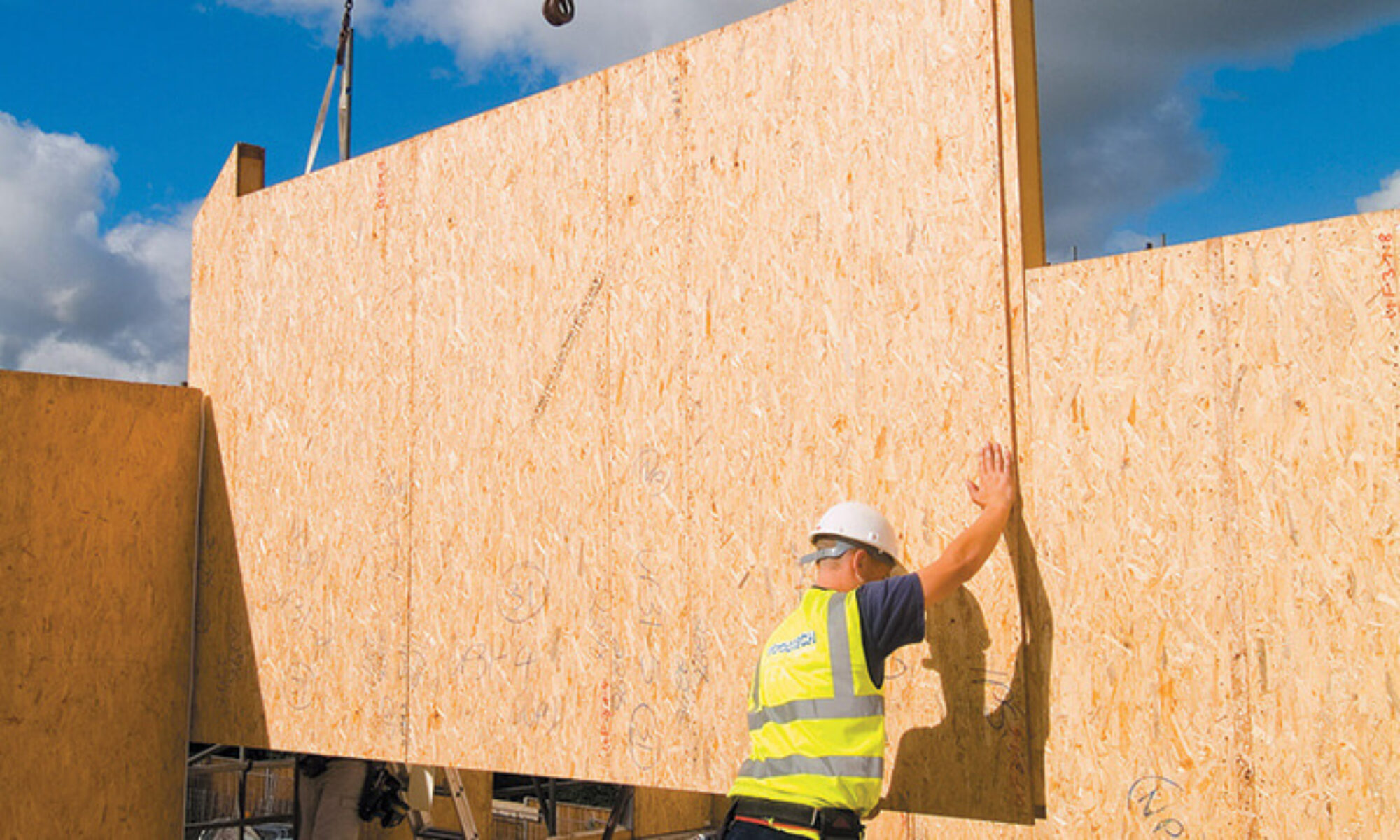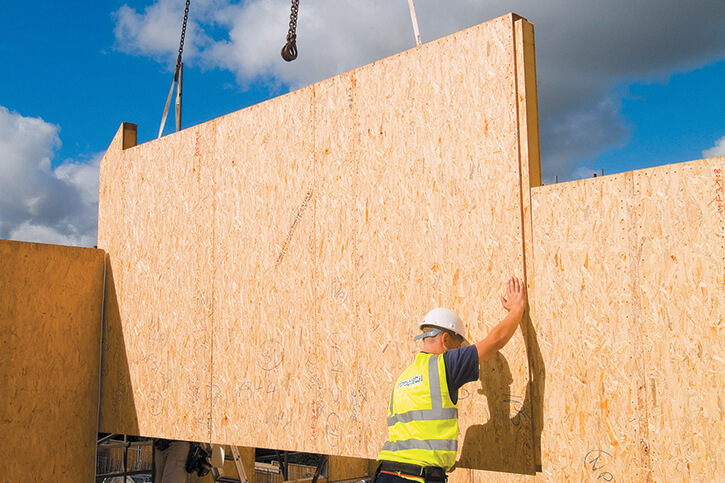As I write this I am currently sitting in a traditional brick and block house with ordinary roof trusses keeping the cold rain off our heads. May i say my home is also my office, sweetly appropriate for a property developers home to be his office. It’s also good to avoid other human beings during these strange COVID times.
Why am I spending an afternoon writing about SIP panels, you may ask? well it will all conclude to importance over the course of the next few articles i write.
So what is a SIP panel?
A SIP panel is a structurally insulated panel, made up of polystyrene with OSB sandwiching it together creating what is a ‘Structural’ Insulated Panel. As it says on the tin has the capacity to be structural whilst also maintaining high insulating Value, or as is known in construction and environmental nerds-alike, U values.
Pic: Kingspan Tec
How does a flimsy bit of OSB board and Polystyrene which is essentially the ingredients for packaging from IKEA, hold up your house?
Well in fact OSB has a really good shear strength and as it commonly touted online ‘twice the strength of Plywood’ which we always think o being the strongest due to its bilateral directions in wood grain. OSB also has a minor flexibility which stops the board from cracking.
Its strength is so much so that it can hold a house when combined with polystyrene and a secondary layer of OSB, and more importantly a high loading strength. The OSB is usually of OSB3/4 quality which means it has a higher load bearing as well as weather durable. Last thing you need is your SIP panel turning soggy like a lost digestive in your cup of tea.
Insulation
Then we have the insulation. The core is usually expanded or extruded polystyrene foam or sometimes it is polyurethane. All of them have high insulation values (U-values). 172mm thick SIP panel is capable of a 0.16 W/m²·K U value which to put it in real terms is the same as U value of rockwool. The added benefit is that the 172mm thickness of the SIP panel is almost the entire thickness of the wall where to have a normal insulated cavity wall you have a 100mm thick block internal, a insulated cavity of 100mm which varies in how much insulation depth you have within that 100mm, ranging from 50mm up to full fill cavities plus the brick work of another 100mm. All in all, you’re talking about a 300mm thick wall (shown below) . A SIP Panel has the capability of halving this.
Pic: isoboard
Why use a SIP Panel?
Is it cost?
Well yes and no. In terms of materials and labour supplied, SIP panels usually work out more expensive than your traditional masonry built house, however the superstructure of a house can be built in 2 weeks as opposed to the usual 10-12 weeks of a house. So if you are a builder or developer, yes you are saving money, because time is money.
Thinner walls,
we discussed this already. You can save 600mm of space across a square shaped four wall house. In times of inflated house and land prices, it’s important.
Thermal Performance
SIP panels are unrivalled in efficiency as they can create passive houses. The bench mark and God of high efficiency ratings for construction. If done property you can look at a saving of 50%. To create a passive house involves many things but one big aspect of a passive house is air tightness, which the SIP panel can create due to its ability to interlock with the other panels using a sort of tongue and groove profiling that SIP panels have, this also reduces thermal bridging down to almost nothing (thermal bridging- moving coldness from outside to in or vice versa). Even the mortar in brickwork can allow for cold bridging.
Design flexibility
Much like ICFs (that’s for another time), they allow for flexibility on style and design as within reason you can cut them to shape, or at least they can be manufactured that way. The architect’s dream!
The roof
Lets not forget the roof of a house. Yes that’s right a SIP panel can be used to build the roof too. Not only you can, you should. Like I previously said Air tightness and high insulation. Both things a roof isn’t good at naturally doing. SIP panel roofs allow for speed, flexibility, maneuverability and high thermal values.
Acoustic values
To reduce sound you need to trap air and you need density both of which SIPs provide, which means if you live by a busy road, noisey town or have issues with the local Raves then SIPs will do you wonders. It can reduce sound by as much as 31dB.
Supply and Fit
Sip panels are becoming evermore used in modern day construction in the UK, which means its availability is pretty good and if anything is plentiful, not long the usual nonsense you get with brick shortgages. There are 101 companies who can provide you with SIPs, however the most well known and high quality of manufacturers are Kingspan. https://www.kingspan.com/gb/en-gb/products/structural-insulated-panels-sips
Kingspan also now offers a fitting service too, which usually includes the engineering drawings to go with it for building regulations approval.
Fitting SIPs can be a DIY job however this is not a one man job even if they are light. They are still too heavy for one person to carry and way too cumbersome to move. Good news is get a couple of your mates over you’ll be fine. The way you bond them together is with expanding foam so you don’t need bricklaying skills, just a steady hand to stop you filling up your nostrils with spray foam.
It’s not all good!
I feel inspired to write this article as a totally positive one but one must be realistic and know that SIPs are not appropriate for all situations.
Weather
Although generally speaking SIPs are weather resistant, they are not completely moisture resistant, which means that they will always require some sort of barrier to elements be it, bricks, brick slips, cladding, membranes and so on and so forth. So a basement may not be the best use of a SIP unless coupled with another system which then renders a SIP an expensive piece of insulation.
We are currently building a house in Kent that the back of a wall sits against a retaining wall and for that reason we decided not to use SIPs as it would have affected the integrity of the panel to brick and block it. I am happy to be wrong and if anything would be a pleasure to be educated that it can be done.
Rodent and insects
Both of the above can eat into wood and also consume foam, not tasty to you or i but a delicious meal to some pests. Which means we need further protection on this front which chemicals such as Boric Acid can be used.
Too airtight!
The nature of SIP panels and what makes them so great is that they are airtight due to their construction. The problem with a building is if it becomes too airtight then oxygen levels can drop and carbon dioxide levels can rise, which means adequate ventilation is required, not only adequate but highly efficient. So efficient so that it needs to bring in fresh air and let out stale air without losing heat, or that just defeats the purpose of a SIP, especially if you are building a Passivhaus. If you dont use a specialist ventilation system then you may fall short of actually keeping the heat in.
Not so good for refurbishment…
It’s not the best use of materials and refurbishing a property because you have to either knock down existing walls or you build up wall thickness. The other thing is SIPs are usually pre designed to work as an entire system so to make it fit with a refurb you will have to adhoc change the design of the SIP which may affect its integrity both from a structural and or an insulation point.


